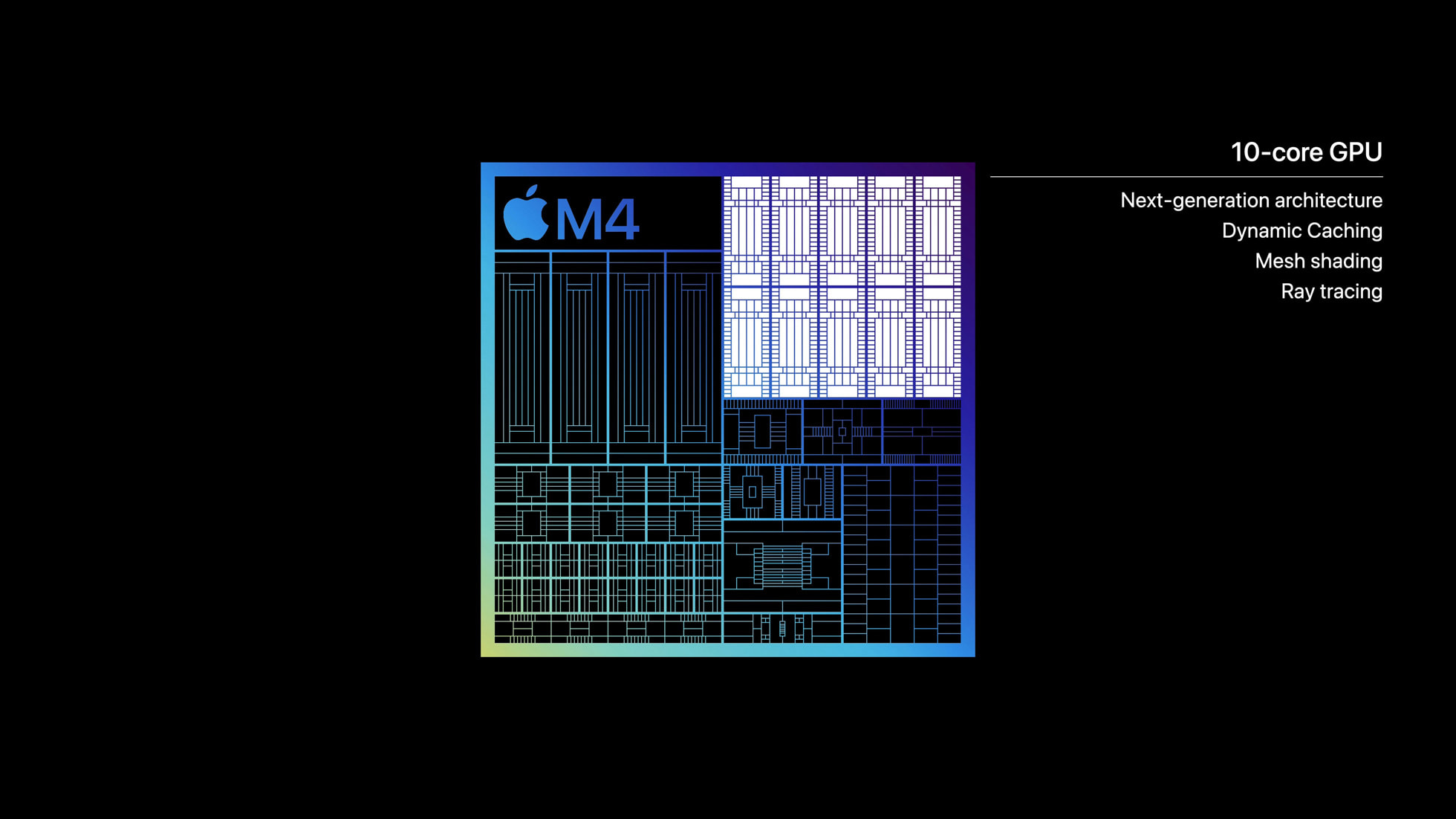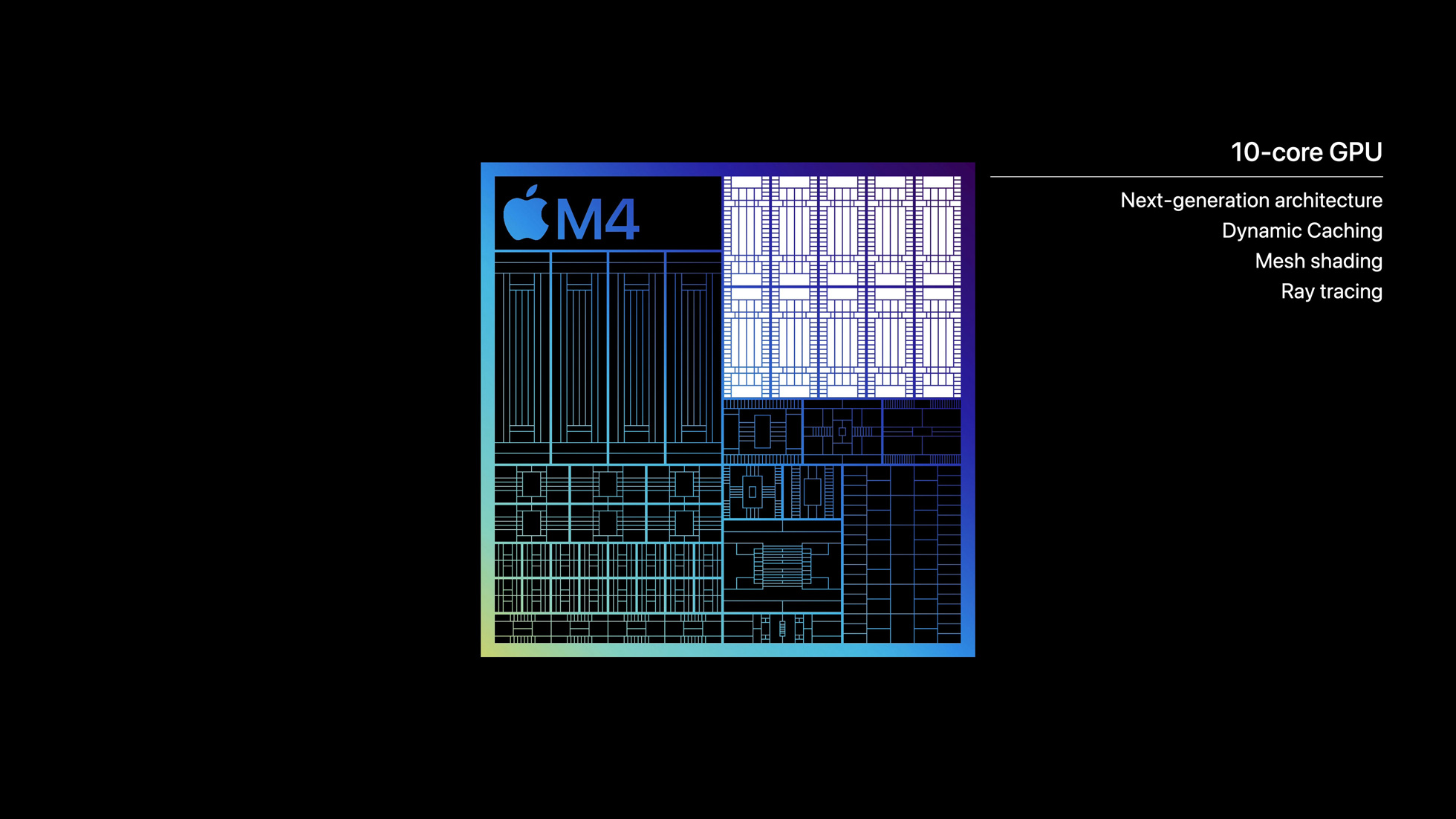
Apple announced its latest processor, the M4, in a video event today. The new chip, which is meant to focus on AI performance, will debut in the new iPad Pro tablets — the first time Apple has introduced an M-series chip in an iPad rather than a Mac.
The M4 is built on a 2nd-generation 3-nanometer process. It features four performance cores, six efficiency cores, and a 10-core GPU that brings ray tracing and hardware-accelerated mesh shading to the iPad for the first time. Apple called out the greater chip industry for just starting to put NPUs in its chips, while Apple has been doing it for years. The M4's new 16-core neural engine supports 38 trillion operations per second. In total, Apple's latest chip has over 28 billion transistors on board.
The reason for the sudden jump to M4 is Apple's new iPad Pros, which include new AI features (Apple did use the term "AI" rather than "machine learning") and a new screen that uses a novel display engine on M4.
Apple claims that "compared with the latest PC chip in a thin and light laptop, M4 can deliver the same performance using just a fourth of the power." In its testing notes, Apple says it used an Asus Zenbook 14 OLED (UX3405MA) with an Intel Core Ultra 7 155H and 32GB of RAM for the comparison.
The M4 brings AV1 hardware acceleration to the iPad for the first time, alongside H.264, HEVC, and ProRes. Alongside the new chip and tablets, Apple showed off new AI features for Logic Pro and Final Cut Pro.





iPad Pro (11-inch and 13-inch)
The first devices to use Apple’s new powerful M4 chip are the new 11-inch and 13-inch iPad Pro. Apple’s ambitions regarding performance for the new generations of iPad Pros meant that the existing M3 processor just wouldn’t do – which is where the M4 comes into play.
According to Apple, when used in the iPad Pro, the M4 is 50% faster than the M2 used in the previous generation models. Alternatively, the M4 can deliver the same performance as the M2 while using half the power. Apple was also able to deliver 20% improved thermal performance thanks to the use of copper in Apple logo and graphite sheets in iPad housing.





The other big news is with the displays, which are now OLED-based. Apple uses Tandem OLED panels in each iPad Pro, combining the light from both. The new display is called Ultra Retina XDR, and delivers 1,000 nits full screen brightness and 1,600 nits peak HDR brightness. Apple has also added an option for a nano-texture finish for the display.
The 13-inch iPad Pro is Apple’s thinnest device to-date at just 5.1mm, while the 11-inch model is slightly thicker at 5.3mm. Like the new iPad Airs, the 12MP FaceTime HD camera on the new iPad Pros has been moved to the side of the device, which makes it easier for video conferencing (and while using the Magic Keyboard).
The new 11-inch iPad Pro starts at $999, while the larger 13-inch model starts at $1,299. Both now come standard with 256GB of storage, which is double the amount of their predecessors. Preorders start today, with shipments commencing next week.
iPad Air (11-inch and 13-inch)

Apple also announced an all-new iPad Air, which now is available in two screen sizes: 11 inches and 13 inches. While the exterior design is not a huge leap forward, there are some minor revisions to make the user experience better. For example, the 12MP FaceTime HD camera has been repositioned from the top of the device to the side — this puts the camera in the optimum position when using the iPad Air in a landscape orientation. The stereo speakers have also been optimized for use in landscape orientation, and Apple claims that the 13-inch model has twice the bass compared to the smaller 11-inch model.
While the previous iPad Air used an M1 chip, the new 11-inch and 13-inch models use the M2 chip. Apple says that it is up to 50% faster than the M1. Other additional features include support for the Apple Pencil “hover” feature, which was previously only available on Apple’s flagship iPad Pros. In addition, Apple has doubled the amount of base storage, which should appease critics. Now, the iPad Air comes with 128GB of standard storage, and the new Air also supports a maximum of 1TB of onboard storage.
The 11-inch and 13-inch iPad Airs are available for preorder today starting at $599 (the same as the previous generation model) and $799, respectively. The two tablets will ship next week.







